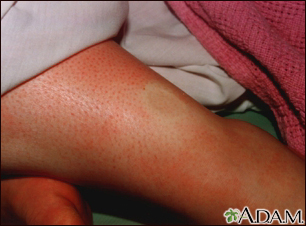Pregnancy SmartSiteTM
Edema; Anasarca DefinitionSwelling is the enlargement of organs, skin, or other body parts. It is caused by a buildup of fluid in the tissues. The extra fluid can lead to a rapid increase in weight over a short period of time (days to weeks). Swelling can occur all over the body (generalized) or only in one part of the body (localized). ConsiderationsSlight swelling (edema) of the lower legs is common in warm summer months, especially if a person has been standing or walking a lot. General swelling, or massive edema (also called anasarca), is a common sign in people who are very sick. Although slight edema may be hard to detect, a large amount of swelling is obvious. Edema is described as pitting or non-pitting.
CausesSwelling can be caused by any of the following:
Home CareFollow your health care provider's treatment recommendations. If you have long-term swelling, ask your provider about options to prevent skin breakdown, such as:
Continue with your everyday activities. When lying down, keep your arms and legs above your heart level, if possible, so the fluid can drain. DO NOT do this if you get shortness of breath. See your provider instead. When to Contact a Medical ProfessionalIf you notice any unexplained swelling, contact your provider. What to Expect at Your Office VisitYour provider will take your medical history and will perform a physical examination. You may be asked about the symptoms of your swelling. Questions may include when the swelling started, whether it is all over your body or just in one area, what you have tried at home to help the swelling. In an emergency situation (pulmonary edema), rapid diagnosis and treatment is important. Tests that may be done include:
Treatment may include avoiding salt or taking water pills (diuretics). Your fluid intake and output should be monitored, and you should be weighed daily. Avoid alcohol if liver disease (cirrhosis or hepatitis) is causing the problem. Support hose may be recommended. ReferencesMcGee S. Edema and deep vein thrombosis. In: McGee S, ed. Evidence-Based Physical Diagnosis. 5th ed. Philadelphia, PA: Elsevier; 2022:chap 56. Swartz MH. The peripheral vascular system. In: Swartz MH, ed. Textbook of Physical Diagnosis: History and Examination. 8th ed. Philadelphia, PA: Elsevier; 2021:chap 15. | |
| |
Review Date: 10/20/2022 Reviewed By: Linda J. Vorvick, MD, Clinical Professor, Department of Family Medicine, UW Medicine, School of Medicine, University of Washington, Seattle, WA. Also reviewed by David C. Dugdale, MD, Medical Director, Brenda Conaway, Editorial Director, and the A.D.A.M. Editorial team. The information provided herein should not be used during any medical emergency or for the diagnosis or treatment of any medical condition. A licensed medical professional should be consulted for diagnosis and treatment of any and all medical conditions. Links to other sites are provided for information only -- they do not constitute endorsements of those other sites. No warranty of any kind, either expressed or implied, is made as to the accuracy, reliability, timeliness, or correctness of any translations made by a third-party service of the information provided herein into any other language. © 1997- A.D.A.M., a business unit of Ebix, Inc. Any duplication or distribution of the information contained herein is strictly prohibited. | |

 Pitting edema on t...
Pitting edema on t...
